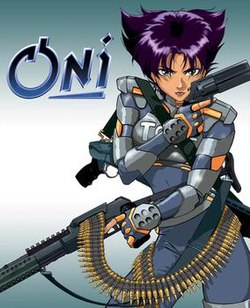Oni (video game)
| Oni | |
|---|---|
 |
|
| Developer(s) | Bungie West |
| Publisher(s) |
Gathering (Windows & Mac) Rockstar Games (PS2) |
| Distributor(s) | Take-Two Interactive |
| Producer(s) | Hamilton Chu |
| Designer(s) | Hardy LeBel |
| Composer(s) | Michael Salvatori |
| Platform(s) | Microsoft Windows, Mac OS, PlayStation 2 |
| Release date(s) |
Windows & Mac OS PlayStation 2 |
| Genre(s) | Action, beat 'em up, third-person shooter, cyberpunk, biopunk |
| Mode(s) | Single-player |
| Aggregate scores | |
|---|---|
| Aggregator | Score |
| GameRankings | (PC) 75.44% (PS2) 68.69% |
| Metacritic | (PC) 73/100 (PS2) 69/100 |
| Review scores | |
| Publication | Score |
| AllGame | |
| Edge | 7/10 |
| EGM | 3.33/10 |
| Eurogamer | 7/10 |
| Game Informer | 6.5/10 |
| GamePro | |
| Game Revolution | B |
| GameSpot | (PS2) 7.1/10 (PC) 6.9/10 |
| GameSpy | 80% |
| GameZone | (PC) 9/10 (PS2) 8/10 |
| IGN | (PC) 7.5/10 (PS2) 7.3/10 |
| OPM (US) | |
| PC Gamer (US) | 72% |
| The Cincinnati Enquirer | |
| Playboy | 75% |
Oni is a third-person action video game developed by Bungie West, a division of Bungie. Released in 2001, it was Bungie West's only game. It broke new ground by blending third-person shooting with hand-to-hand combat. A PlayStation 2 port was developed by Rockstar Canada.
There are ten different guns in Oni, including handguns, rifles, rocket launchers, and energy weapons. Power-ups such as "hyposprays", which heal damage, and cloaking devices, which render the player invisible, can be found scattered throughout the levels or on corpses. Since the player can carry only one weapon at a time and ammunition is scarce, hand-to-hand combat is the most effective and common means of defeating enemies. The player can punch, kick, and throw enemies; progressing into later levels unlocks stronger moves and combos.
There are multiple classes of enemy, each with its own style of unarmed combat. Each class is subdivided into tiers of increasing strength. As in Bungie's earlier Marathon titles, tiers are color-coded, in this case by green (weakest), blue, and red (strongest). Also color-coded are the levels of health each opponent has, indicated by a flash when the player strikes or shoots them. Green flashes show the opponent has high health, red flashes show the enemy is near death.
Oni does not confine the player to fighting small groups of enemies in small arenas; each area is fully open to explore. The fourteen levels are of various sizes, some large enough to comprise an entire building. Bungie hired two architects to design the buildings.
The Oni engine implements a method of interpolation that tweens key frames, smoothing out the animation of complex martial-arts moves. However, frame slippage is a common problem when multiple non-player characters near the player are attacking.
...
Wikipedia
